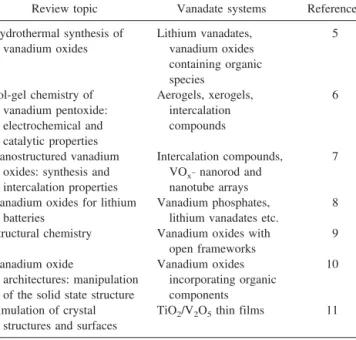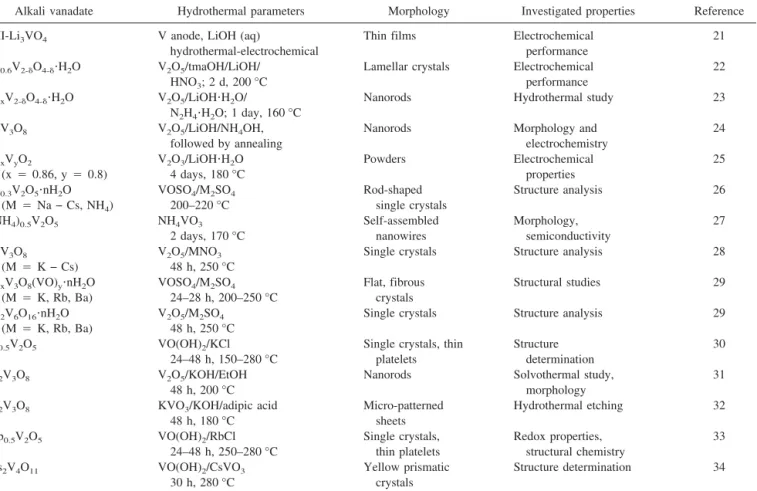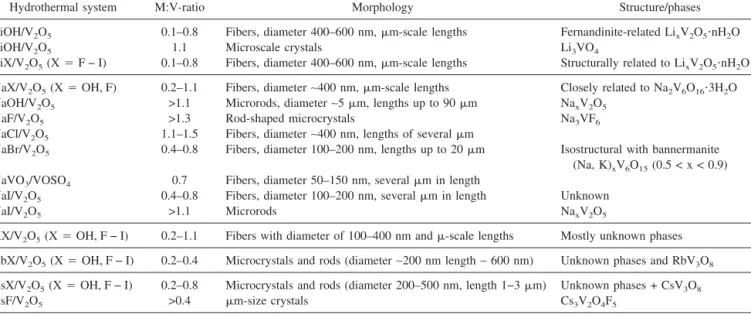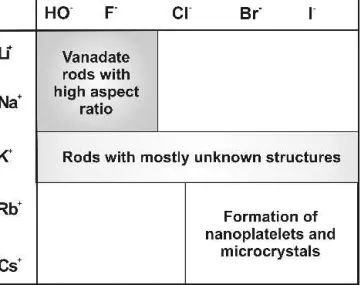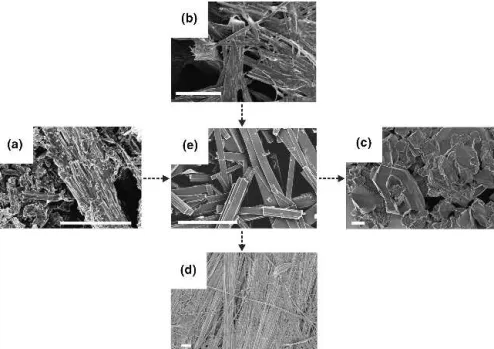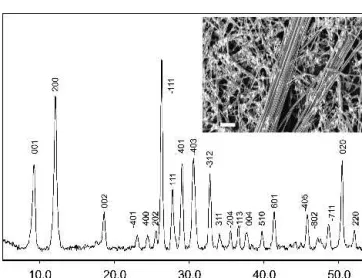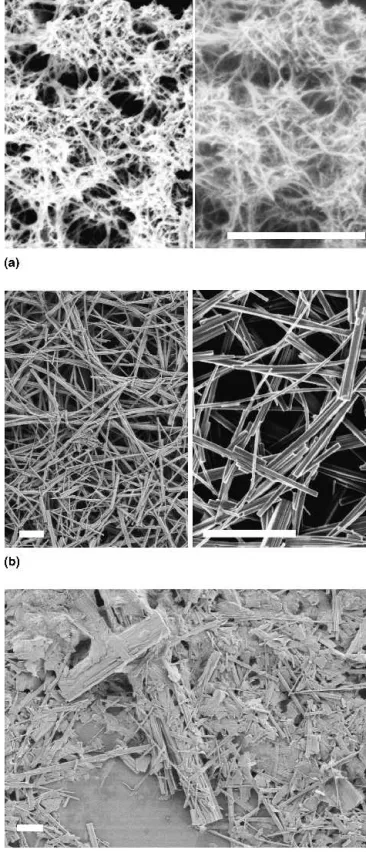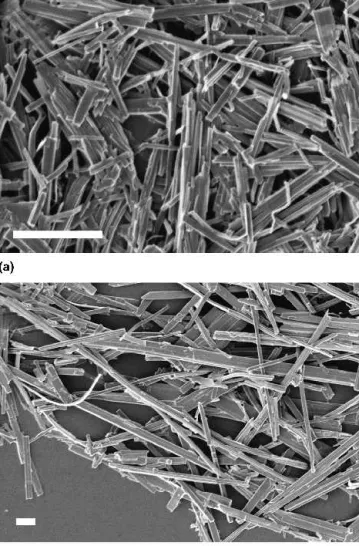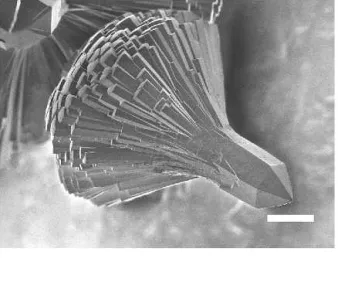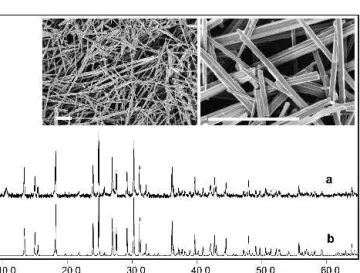Papers in this section are based on submissions to the MRS Symposium Proceedings that were selected by Symposium Organizers as the outstanding paper. Upon selection, authors are invited to submit their research results to Journal of Materials Research. These papers are subject to the same peer review and editorial standards as all other JMR papers. This is another way by which the Materials Research Society recognizes high quality papers presented at its meetings.
Hydrothermal synthesis of anisotropic alkali and alkaline
earth vanadates
Alexej Michailovski and Michael Wörle
Laboratory of Inorganic Chemistry, ETH Zurich, CH-8093 Zurich, Switzerland Denis Sheptyakov
Laboratory for Neutron Scattering, ETH Zurich & PSI Villigen, CH-5232 Villigen PSI, Switzerland Greta R. Patzkea)
Laboratory of Inorganic Chemistry, ETH Zurich, CH-8093 Zurich, Switzerland
(Received 18 April 2006; accepted 12 July 2006)
In the course of a systematic field study, anisotropic alkali and alkaline earth vanadates have been accessed through a straightforward, one-step hydrothermal process. They are formed quantitatively from V2O5and alkali- or alkaline earth halide solutions after a
few days of autoclave treatment in the temperature range between 100 and 220 °C. The presence of ionic additives leads to an interplay between the formation of isotropic crystalline phases and the production of fibrous oxide materials, such as a novel magnesium vanadate. The influence of the hydrothermal parameters and of the alkali/alkaline earth halides on the emerging phases and morphologies has been investigated in the course of a systematic study. The results are compared with other vanadate- and transition metal oxide-based hydrothermal systems, and the emerging trends are discussed with respect to the development of predictive synthetic concepts for nanostructured vanadium oxides.
I. INTRODUCTION
Anisotropic oxidic nanoparticles are important tools for a future nanotechnology,1 and hydrothermal meth-ods2provide a versatile and efficient synthetic approach for their large-scale synthesis. Their preparative conve-nience has recently been demonstrated for the formation of molybdenum oxide fibers,3,4
and the present study is focused on a hydrothermal pathway to anisotropic vana-dates. The hydrothermal preparation and the sol-gel chemistry of vanadium oxides has been in the focus of research interest over the past decades. In combination with the exceptionally rich structural chemistry of vana-dates, these efforts have brought forward a multitude of promising novel materials. Table I provides a summary of review articles covering this extensive field of vanadate-based materials chemistry.5–11 The structural chemistry of vanadium oxides benefits from the variety of vanadium oxidation states and the manifold coordina-tion environments that vary from tetrahedra over trigonal
and square pyramids to regular and distorted octahedra.9 These polyhedra can be combined into cluster com-pounds, chain and layer structures, and three-dimensional frameworks.12 They exhibit a wide spec-trum of important applications, especially in cataly-sis13,14
and in electrochemistry.15
The materials chemistry of vanadates could be substantially enhanced by shape-controlling syntheses on the nanoscale,16,17
such as the formation of vanadium oxide nanotubes18,19
or the self-assembly of VO2nanorods. 20
The scope of the present study is a hydrothermal field screening of the MXn/V2O5 (n ⳱ 1, 2; M ⳱ alkali/
alkaline earth cation; X ⳱ OH, F − I) systems with respect to the formation of anisotropic vanadates with diameters on the nano- and submicrometer scale. Although numerous studies have been conducted on the hydro-thermal preparation of specific alkali and alkaline earth vanadates (cf. the summary in Tables II and III),21–44 their morphochemistry is still far from explored, let alone the hydrothermal mechanisms leading to fiber forma-tion. Thus, we present the first comparative morphologi-cal study vanadates formed by the hydrothermal inter-action of V2O5with alkali/alkaline earth hydroxides and
halides. These systems were selected for the following reasons.
a)
Address all correspondence to this author. e-mail: patzke@inorg.chem.ethz.ch
This paper was selected as the outstanding meeting paper for the 2005 MRS Spring Meeting Symposium Y Proceedings, Vol. 878E. DOI: 10.1557/JMR.2007.0002
The idea of tuning the aspect ratio of nanoparticles by the use of capping additives in hydrothermal synthesis is intriguing and has been demonstrated for various oxidic materials such as ZnO.45However, it may still take con-siderable optimization effort to single out additive sub-stances for vanadate systems because corresponding studies on the additive-assisted hydrothermal growth of anisotropic molybdenum oxides have shown that the ma-jority of the investigated substances either did not exert a significant morphology control under the given condi-tions or that they were incorporated to form new molyb-dates.46
Selected combinations of ionic additives may provide an alternative way of generating new morpholo-gies: when molybdenum(VI)-precursors were reacted in mixed alkali halide solutions, a new type of fibrous ce-sium potasce-sium molybdates emerged.47
In the course of catalytical studies, the crystal mor-phology of V2O5has been simulated, and the results have
been applied to develop a model for V2O5/TiO2 thin
films.11 Nevertheless, little is known about the interac-tion of vanadate surfaces with alkali/alkaline earth cat-ions. In the following paragraphs, the main trends emerg-ing from our extensive hydrothermal parameter study (encompassing over 200 experiments) are presented. This systematic investigation has been devised to single out the most promising systems with respect to aniso-tropic vanadate growth as a starting point for forthcom-ing detailed explorations of their formation processes and applications: firstly, the MX/V2O5-systems (M ⳱ Li,
Na) are discussed as representative examples that outline the preparative assets and drawbacks of the hydrothermal approach. Furthermore, key results concerning the use of alkaline earth-based additives are presented.
II. EXPERIMENTAL
If not mentioned otherwise, a standard hydrothermal experiment was performed as follows: 360 mg V2O5
(Fluka, 99.5%) and the appropriate amount of additive (alkali/alkaline earth halide or hydroxide; Fluka, Aldrich, min. >99.5%) necessary to adjust the initial M:V-ratio were added together with 1.5 mL of distilled water to a Teflon-lined stainless steel autoclave with the capacity of 23 mL. The autoclave was then sealed, heated at 180 °C for 6 days and subsequently cooled to room temperature. The precipitate was collected after filtration, washed with distilled water, ethanol, and ether and dried in air. Based on this standard procedure, a total of over 200 parameter screening experiments was performed with emphasis on the influence of the M:V-ratio on the structure and mor-phology of the products. X-ray powder analysis was con-ducted on a STOE STADI-P2 diffractometer (STOE & Cie., Darmstadt, Germany) in transmission mode (flat sample holders, Ge-monochromated CuK␣1 radiation) equipped with a position sensitive detector (resolution ∼0.01° in 2 ). The synchrotron x-ray powder diffraction data for Mg7-x(VO4)4(OH)3(cf. Fig. 9) were collected at
the BM16 beamline of the European Synchrotron Radia-tion Facility (ESRF) with the wavelength of 0.5018 Å. For scanning electron microscopy (SEM), performed on a LEO 1530 (FEG) microscope with 1 keV electrons, samples were dispersed in ethanol and subsequently de-posited on a silicon wafer. Alkali metal:vanadium-ratios were determined by means of inductively coupled plasma (ICP) analysis (ELAN 6100 DRC, Perkin Elmer/ Sciex) in the standard mode. For the determination of alkali contents, 20–40 mg of the fibrous vanadates were dissolved in 65% nitric acid and adjusted to an overall acid concentration of 2%. The obtained solution was di-luted (1:40) with double distilled water and readjusted to 2% nitric acid for analysis of the vanadium content. III. RESULTS: HYDROTHERMAL SYNTHESIS OF ANISOTROPIC ALKALI VANADATES
A. Hydrothermal screening experiments in the MX/V2O5systems (M = Li − Cs; X = OH, F − I)
The choice of the alkali cation exerts a key influence on the morphology of the products emerging from the hydrothermal formation of anisotropic alkali vanadates. All results are summarized in Tables IV to VI. The smaller alkali cations, Li+ and Na+, display the highest tendency towards fiber formation, whereas the average degree of anisotropy in the products declines with in-creasing size of the alkali cation. Moreover, the role of the anion must be taken into account: the “hardest” an-ions, OH−and F−, favor the growth of fibrous products, whereas the “softer” halides (Cl−–I−) tend to reduce the aspect ratio of the emerging alkali vanadate parti-cles. However, an excess of alkali hydroxide and fluoride
TABLE I. Selection of review articles covering the solution-based synthesis and materials chemistry of vanadates.
Review topic Vanadate systems Reference Hydrothermal synthesis of vanadium oxides Lithium vanadates, vanadium oxides containing organic species 5 Sol-gel chemistry of vanadium pentoxide: electrochemical and catalytic properties Aerogels, xerogels, intercalation compounds 6 Nanostructured vanadium oxides: synthesis and intercalation properties
Intercalation compounds, VOx−nanorod and
nanotube arrays
7
Vanadium oxides for lithium batteries
Vanadium phosphates, lithium vanadates etc.
8
Structural chemistry Vanadium oxides with open frameworks
9
Vanadium oxide
architectures: manipulation of the solid state structure
Vanadium oxides incorporating organic components
10
Simulation of crystal structures and surfaces
solutions is counterproductive, because starting materials with X:V-ratios of 1.1 and above frequently lead to the formation of microcrystalline, non-anisotropic vanadates and fluorovanadates instead of fibers with a high aspect
ratio. The impact of the anions and of the cations can be summarized in “synthetic fields”48 (Fig. 1), and representative morphologies are shown in Fig. 2. All in all, the NaX/V2O5(X⳱ OH, F − Br) and LiOH/V2O5
TABLE II. Literature survey of hydrothermal syntheses of alkali vanadates.
Alkali vanadate Hydrothermal parameters Morphology Investigated properties Reference
II-Li3VO4 V anode, LiOH (aq)
hydrothermal-electrochemical
Thin films Electrochemical
performance
21
Li0.6V2-␦O4-␦⭈H2O V2O5/tmaOH/LiOH/
HNO3; 2 d, 200 °C
Lamellar crystals Electrochemical performance
22
LixV2-␦O4-␦⭈H2O V2O5/LiOH⭈H2O/
N2H4⭈H2O; 1 day, 160 °C
Nanorods Hydrothermal study 23
LiV3O8 V2O5/LiOH/NH4OH,
followed by annealing
Nanorods Morphology and
electrochemistry 24 LixVyO2 (x⳱ 0.86, y ⳱ 0.8) V2O3/LiOH⭈H2O 4 days, 180 °C Powders Electrochemical properties 25 M0.3V2O5⭈nH2O (M⳱ Na − Cs, NH4) VOSO4/M2SO4 200–220 °C Rod-shaped single crystals Structure analysis 26 (NH4)0.5V2O5 NH4VO3 2 days, 170 °C Self-assembled nanowires Morphology, semiconductivity 27 MV3O8 (M⳱ K − Cs) V2O5/MNO3 48 h, 250 °C
Single crystals Structure analysis 28
MxV3O8(VO)y⭈nH2O (M⳱ K, Rb, Ba) VOSO4/M2SO4 24–28 h, 200–250 °C Flat, fibrous crystals Structural studies 29 M2V6O16⭈nH2O (M⳱ K, Rb, Ba) V2O5/M2SO4 48 h, 250 °C
Single crystals Structure analysis 29
K0.5V2O5 VO(OH)2/KCl
24–48 h, 150–280 °C
Single crystals, thin platelets Structure determination 30 K2V3O8 V2O5/KOH/EtOH 48 h, 200 °C
Nanorods Solvothermal study,
morphology
31
K2V3O8 KVO3/KOH/adipic acid 48 h, 180 °C Micro-patterned sheets Hydrothermal etching 32 Rb0.5V2O5 VO(OH)2/RbCl 24–48 h, 250–280 °C Single crystals, thin platelets Redox properties, structural chemistry 33 Cs2V4O11 VO(OH)2/CsVO3 30 h, 280 °C Yellow prismatic crystals Structure determination 34
TABLE III. Literature survey of hydrothermal syntheses of alkaline earth vanadates.
Alkaline earth vanadate Hydrothermal parameters Morphology Investigated properties Reference Calcium vanadates
(e.g., smerwoodite)
V2O5/Ca(OH)2; 20–350 atm, 200–600 °C
mm-size fibers Hydrothermal study 35
Ca0.25V2O5⭈H2O VO2/CaCl2 48 h, 280 °C
Single crystals Structure analysis 36
SrV4O9 NaVO3/SrCl2/NMe4Cl 48 h, 350 °C
Light green crystals Structure determination 37
BaV2O6 VO(OH)2/Ba(NO3)2
24–48 h, 280 °C
Columnar single crystals
Structure determination 38
BaV3O8 VO(OH)2/BaCl2
40 h, 270 °C
Single crystals (black rods)
Structure determination 39
Ba0.4V3O8(VO)0.4⭈nH2O VOCl2/BaCl2 24 h, 240 °C
Thin, long plates
Structure determination 40
BaV6O16⭈nH2O VO(OH)2/BaCl2
24–48 h, 250–280 °C Needle-shaped single crystals Structure determination 41 BaV7O16⭈nH2O V-anode/Ba(NO3)2 hydrothermal-electrochemical
Single crystals Structure determination 42
Ba1+xV8O21 VO2/Ba(NO3)2
40 h, 350 °C
Columnar crystals Structure determination 43
Ba6[V10O30(H2O)]⭈2.5H2O NaVO3/BaI2/NMe4I
40 h, 280 °C
hydrothermal systems (cf. highlighted part of Fig. 1) ex-hibit the strongest tendency toward the formation of highly anisotropic and phase pure fibers among the sys-tems investigated in this study. Therefore, they are dis-cussed in detail in Secs. III. B and III. C.
Although the KX/V2O5 (X ⳱ OH, F − I) systems
provide access to a broad spectrum of anisotropic potas-sium vanadates, they will not be discussed in detail because the majority of the products have not been structurally characterized up to now due to the difficulties outlined below for the LiOH/V2O5system (cf. Sec. III. B).
The same applies for the rubidium- and cesium-based systems when combined with the softer halides (Cl−−I−). Unlike their lithium- and sodium-based analogues, the MX/V2O5(M⳱ Rb, Cs; X ⳱ OH, F) systems exhibit a
low tendency toward vanadate fiber growth, and micro-crystalline MV3O8 (M ⳱ Rb, Cs) vanadates are often
formed instead (Fig. 2, bottom, left). Furthermore, mm-sized crystals of fluorovanadates, such as Cs3V2O4F5,
49
emerge from F:V-ratios above 1.1. As the known synthetic routes to fluorovanadates may require several synthetic steps including the use of HF,50their one-step hydrothermal preparation from the alkali fluorides and V2O5 is a convenient preparative alternative.
B. Fibrous lithium vanadates in the LiX/V2O5
(X = OH, F − I) hydrothermal systems
Among the various types of lithium vanadate fibers resulting from the hydrothermal reaction of V2O5in LiX
(X⳱ OH, F − I) solutions, the products grown in the presence of LiOH exhibit the highest degree of crystal-linity and anisotropy. The lithium vanadate rods exhibit average diameters in the range of 400–600 nm and lengths extending up to several micrometers (cf. Fig. 3 and Table IV). They are formed within a specific
TABLE IV. Summary of experimental results (cf. Sec. III) on the hydrothermal formation of anisotropic alkali vanadates.
Hydrothermal system M:V-ratio Morphology Structure/phases
LiOH/V2O5 0.1–0.8 Fibers, diameter 400–600 nm,m-scale lengths Fernandinite-related LixV2O5⭈nH2O
LiOH/V2O5 1.1 Microscale crystals Li3VO4
LiX/V2O5(X⳱ F − I) 0.1–0.8 Fibers, diameter 400–600 nm,m-scale lengths Structurally related to LixV2O5⭈nH2O
NaX/V2O5(X⳱ OH, F) 0.2–1.1 Fibers, diameter∼400 nm, m-scale lengths Closely related to Na2V6O16⭈3H2O
NaOH/V2O5 >1.1 Microrods, diameter∼5 m, lengths up to 90 m NaxV2O5
NaF/V2O5 >1.3 Rod-shaped microcrystals Na3VF6
NaCl/V2O5 1.1–1.5 Fibers, diameter∼400 nm, lengths of several m
NaBr/V2O5 0.4–0.8 Fibers, diameter 100–200 nm, lengths up to 20m Isostructural with bannermanite
(Na, K)xV6O15(0.5 < x < 0.9)
NaVO3/VOSO4 0.7 Fibers, diameter 50–150 nm, severalm in length
NaI/V2O5 0.4–0.8 Fibers, diameter 100–200 nm, severalm in length Unknown
NaI/V2O5 >1.1 Microrods NaxV2O5
KX/V2O5(X⳱ OH, F − I) 0.2–1.1 Fibers with diameter of 100–400 nm and-scale lengths Mostly unknown phases
RbX/V2O5(X⳱ OH, F − I) 0.2–0.4 Microcrystals and rods (diameter∼200 nm length ∼ 600 nm) Unknown phases and RbV3O8 CsX/V2O5(X⳱ OH, F − I) 0.2–0.8 Microcrystals and rods (diameter 200–500 nm, length 1−3m) Unknown phases + CsV3O8
CsF/V2O5 >0.4 m-size crystals Cs3V2O4F5
TABLE V. Summary of experimental results (cf. Sec. III) on the hydrothermal formation of anisotropic alkaline earth vanadates.
Hydrothermal system M:V-ratio Morphology Structure/phases
Mg(OH)2/V2O5 0.2–0.4 Fibers: diameter 300–500 nm, length 30m and above Unknown phase
Mg(OH)2/V2O5 0.75 Flower-like needle patterns (∼5 × 130 m) “Mg7-x(VO4)4(OH)3”
Sr(OH)2/V2O5 0.2–0.3 Fibers: diameter 100–200 nm, length 30m and above Unknown phase
Sr(OH)2/V2O5 >0.3 Fibers: diameter 300–2m, length 20 m in length -SrV2O6(+ unknown phase)
Ba(OH)2/V2O5 <0.4 Fibers: diameter 200–500 nm, severalm in length Related to Ba0.97(V6O16)(H2O)1.67
Ba(OH)2/V2O5 0.4–0.8 Fibers: diameter 150–200 nm, up to 5m in length catena-Ba(VO3)2⭈2H2O
TABLE VI. Synthetic profiles of the alkali cations in the hydrother-mal synthesis of anisotropic vanadates.
Cation Typical products Characteristic morphology Li+ Layered lithium vanadates
(mineral-related: fernandinite) Anisotropic, fibrous products Na+ Mineral-related phases (barnesite/bannermanite) Anisotropic, fibrous products K+ Unknown potassium vanadates
Fibrous, less anisotropic
Rb+, Cs+ Unknown phases and
microcrystalline polyoxovanadates
Microcrystals, low degree of anisotropy
parameter window: the Li:V-ratio in the starting ma-terial must be adjusted between values of 0.05 and 0.75 under the standard hydrothermal conditions outlined above (cf. Sec. II). The lithium content in the products increases accordingly from 2 at.% to 22 at.%. The x-ray diffraction (XRD) patterns of this series of fibrous lithium vanadates, LixV2O5·nH2O, are related to that of
the mineral fernandinite (Ca1.44(V7.6Fe0.4O20)(H2O)4). 51
Fig. 4(a) displays the representative XRD pattern [Fig. 4(a– 3)] of the lithium vanadate fibers emerging from an initial Li:V-ratio of 0.38 together with the data for fernandinite [Fig. 4(a–1)]. Both compounds have a similar V2O5layer
structure in common [Fig. 4(b)] and the cations and crys-tal water molecules are located between the layers.
An approximate structural model was derived from powder diffraction data for LixV2O5·nH2O starting from
the fernandinite structure.51 The double layers of edge-and corner-sharing VO5pyramids present in fernandinite
were generated for the triclinic cell [P-1; a⳱ 6.111(5) Å, b ⳱ 10.493(5) Å, c ⳱ 3.643(5) Å, ␣ ⳱ 94.8(2)°,  ⳱ 106.7(2)°, ␥ ⳱ 94.0(2)°]. Whereas a free refine-ment was possible for the vanadium positions, the low data/parameter ratio did not permit a Rietveld refinement where all atom positions were refined freely.
Therefore, the oxygen positions were subsequently ad-justed on the basis of the bond distances and angles ob-served for fernandinite, and the calculated powder dif-fraction patterns were checked against the experimental data. The lithium position was determined from differ-ence electron density maps, but its overall infludiffer-ence on the approximate model is too low to assign the precise lithium content. As a consequence, the oxidation state of the vanadium atoms remains unknown. This preliminary model cannot substitute a precise structure determination from single crystal data. However, the calculated powder data [Fig. 4 (a–2)] shows that it is a reasonable represen-tation of the structural motif present in LixV2O5·nH2O. It
is furthermore analogous to synthetic␦-Ag0.68V2O5, and
it occurs in the “straczekite group” of natural vanadium bronzes as well.52
The strong influence of hydrothermal parameter shifts on the resulting type of lithium vanadate fibers is shown in Fig. 3 for variations of the standard procedure for LixV2O5·nH2O fiber formation [6 days of hydrothermal
treatment at 180 °C starting from a Li:V-ratio of 0.38, cf. Fig. 3(e)]. The timescale of the reaction appears to be rather slow when compared with the minute-scale hydro-thermal production of MoO3 rods:
3
after 4 h of hydro-thermal treatment at 180 °C, V2O5is transformed into a
structurally amorphous fibrous intermediate [Fig. 3(b)], and at least 1–2 days of reaction time are required for the conversion into crystalline fibers. Prolonged reaction times (18 days) lead to an increase in anisotropy of the fibers [Fig. 3(d)]; while their diameters remain in the 100–300 nm range, their lengths are 30m and higher. However, their XRD pattern could not be assigned to a known vanadate type up to now. Fiber formation sets in around 100 °C [Fig. 3(a)]. At 140 °C, fibers with an ex-ceptionally high aspect ratio (diameters around 300 nm and lengths up to 140m) and a hitherto unknown XRD pattern are formed. An increase of the starting Li:V-ratio from 0.38 to 0.56 leads to further alterations of the XRD patterns, and higher LiOH concentrations favor the growth of microcrystalline Li3VO4[Fig. 3(c)].
53
The fernandinite-related fibers were heated for 3 days at 180 °C in air. Although this leads to a loss of crystal-line water, both the morphology and the structural motif of the fibers are maintained.
This renders them suitable for applications at elevated
FIG. 2. Representative morphologies of anisotropic vanadates ob-tained in the hydrothermal MX/V2O5 (M⳱ Na − Cs; X ⳱ OH,
F − I) systems (clockwise): MX⳱ NaBr (bannermanite fibers), KBr (KV3O8fibers), RbCl and CsI (vanadates with a hitherto unidentified
crystal structure).
FIG. 1. Synthetic trends in the alkali halide/hydroxide-assisted hydro-thermal preparation of anisotropic vanadates: the MX/V2O5(M⳱ Li,
Na; X⳱ OH, F) hydrothermal systems (highlighted in the upper left area) afford vanadate fibers with the highest aspect ratios.
temperatures. Further investigations concerning their lithium intercalation behavior are under way.
In summary, the hydrothermal system LiOH/V2O5
ex-hibits the following synthetic characteristics:
(i) The lithium cation is readily incorporated to form a multitude of fibrous vanadates with diameters between 100 and 400 nm and lengths in the micrometer range.
(ii) Among this product spectrum, a careful parameter adjustment is required to address a specific vanadate phase.
(iii) The majority of the products are closely related to the mineral fernandinite, but the high anisotropy of the
fibers renders precise structure determinations from pow-der data extremely difficult.
This applies for the remaining MX/V2O5(M⳱ Na −
Cs; X⳱ OH, F − I) systems as well. Therefore, only the major preparative trends emerging from extensive screening studies in the sodium-based systems are summa-rized in the following section (cf. Table IV and Sec. III. C.). C. Formation of barnesite-related vanadate fibers in the NaX/V2O5systems (X = OH, F)
The hydrothermal reaction of V2O5 with solutions
of NaOH and NaF affords sodium vanadate rods after
FIG. 3. SEM images (scale bar⳱ 3 m) demonstrating the influence of the hydrothermal parameter variations (a–d) on the morphology of lithium vanadate fibers compared with the products obtained under standard conditions [initial Li:V-ratio⳱ 0.38, 6 days, 180 °C, (e)]: (a) deteriorated morphology obtained at 100 °C; (b) amorphous fibers grown after 4 h of reaction time; (c) microcrystalline Li3VO4formed from an initial
Li:V-ratio of 1.1; (d) fibers with a high aspect ratio grown after 18 days.
FIG. 4. (a) Theoretical powder data for fernandinite (1) and for the structural model derived for LixV2O5·nH2O (2) together with the experimental
data for LixV2O5·nH2O (3). (b) Structural model for LixV2O5·nH2O: the lithium cations are intercalated between double layers of corner-sharing
6 days of treatment at 180 °C. The fibers display diam-eters around 400 nm and microscale lengths up to 30m and above (Fig. 5). They are formed within a wide Na:V-range of 0.2–1.1. The highly anisotropic sodium vana-date fibers are structurally closely related to the natural mineral barnesite, Na2V6O16·3H2O (Fig. 5).
54
Their lattice constants [monoclinic, a ⳱ 12.18(4) Å, b⳱ 3.610(8) Å, c ⳱ 7.80(1) Å,  ⳱ 95.3(2)°] agree well with the literature data for barnesite (P2/m, a ⳱ 12.17 Å, b ⳱ 3.602 Å, c ⳱ 7.78 Å,  ⳱ 95.03°).54 Barnesite is a member of the hewettite mineral family with the general composition M2V6O16·nH2O (M ⳱
monovalent) or MV6O16·nH2O (M⳱ divalent). 55
The hewettite minerals have V6O16 layers with
inter-layer metal atoms as a structural motif in common.41The V6O16 layers consist of double layers of edge-sharing
VO6octahedra that are linked to a single chain of
edge-sharing VO5trigonal bipyramids. This structural motif is
present in Li1+xV3O8as well that has recently attracted
interest as a promising cathode material.56,57
The present hydrothermal approach provides a one-step access to gram amounts of sodium hewettite fibers for the study of their reactivity and properties. Although the hewettite series has already been named in 1914, more than 80 years passed by until the first complete structural analysis of a hewettite mineral was published in 1998 with the crystal structure determination of syn-thetic barium hewettite.41
These difficulties in assigning a structural motif to the hewettites were caused by the tendency of the natural minerals to grow as silky fibers that are too small for single crystal analysis.58
The same problem also applies for most of the novel fibrous alkali vanadates obtained in the course of this study.
As has been observed for the lithium-based systems, a further increase of the Na:V-ratio in the starting material
leads to the formation of microcrystalline phases (e.g., Na2V6O16
59
) with no special morphological features and to fluorination reactions (Na3VF6
60
).
D. Formation of bannermanite-related vanadate fibers in the NaX/V2O5 systems (X = Cl, Br)
The formation of sodium vanadate fibers in the NaX/ V2O5(X⳱ Cl, Br) systems differs considerably from the
analogous fluoride- and hydroxide-based systems. This illustrates the influence of the anions (and of the pH in hydroxide systems) on the synthetic process.
Whereas the Na:V-ratio in the starting material can be widely varied for the growth of barnesite-related fibers, the concentration of the NaCl and NaBr additive solu-tions must be adjusted more carefully to obtain fibrous products: for 6 days of hydrothermal treatment at 180 °C, the respective Na:V-parameter windows are 0.4–0.75 for NaBr and 1.1–1.5 for NaCl. As has been observed for the NaOH- and NaF/V2O5systems, the formation of fibrous
vanadates in the NaBr/V2O5 system discontinues at
Na:V-ratios of 2 and above so that microcrystals of NaV6O15
59
are formed in the presence of hitherto uni-dentified phases.
The aspect ratio of the sodium vanadate fibers depends on the anion: NaCl affords fibers with maximum diam-eters of 400 nm and lengths of several micromdiam-eters, whereas the use of NaBr reduces the average fiber diam-eter to 100–200 nm, accompanied by fiber lengths up to 20m. The starting material is quantitatively converted into a fine cobweb of sodium vanadate rods (Fig. 6). These fibers [monoclinic, a ⳱ 15.417(5) Å, b ⳱ 3.614(1) Å, c⳱ 10.094(3) Å,  ⳱ 109.47(3)°] are iso-structural with the natural mineral bannermanite [C2/m,
FIG. 5. XRD pattern and representative SEM image (inset) of barne-site rods generated in the hydrothermal system NaF/V2O5compared
with the JCPDS data for barnesite (16-601).
FIG. 6. XRD pattern and representative SEM image (inset, scale bar⳱ 1 m) of bannermanite rods grown in the hydrothermal system NaBr/V2O5.
a ⳱ 15.413(7) Å, b ⳱ 3.615(2) Å, c ⳱ 10.066(8) Å,  ⳱ 109.29(8)°] (Fig. 6).61
Natural bannermanite is repre-sented by the general formula (Na, K)xV
4+ xV
5+ 6-xO15
(0.54 < x < 0.90), and it is isostructural with -NaxV6O15. Both compounds exhibit a 3D bronze
framework consisting of zigzag sheets of distorted VO6
octahedra that are linked through two square-based pyra-mids sharing edges.62
The sodium sites in bannermanite display a unique 7-fold coordination that has only been found in six other minerals before.62 The hydrothermal formation of the bannermanite tunnel structure under the given conditions requires the presence of chloride and bromide anions in the reaction medium, whereas the use of sodium fluoride solutions clearly favors the formation of the layered barnesite type (cf. Sec. III. C).55 Interest-ingly, the hydrothermal treatment of molybdenum(VI)-precursor materials in alkali halide solutions exhibits a similar influence of the anions on the crystal structure of the resulting molybdates: when chloride and bromide so-lutions are used, hexagonal molybdate phases with a 3D channel structure are preferably formed, while fluoride solutions favor different product types.46
Finally, the NaI/V2O5system affords fibrous materials
with diameters between 100 and 200 nm and micro-scale lengths when the Na:V-ratio in the starting ma-terial is adjusted between 0.4 and 1.3. Unlike the prod-ucts obtained from the NaCl-and NaBr/V2O5 systems,
these fibers do not bear resemblance to known types of vanadates. In summary, the synthetic profiles of the NaX/V2O5-systems vary with increasing polarizability of
the anion from X⳱ F/OH over X ⳱ Cl/Br to X ⳱ I (Table IV).
The hydrothermal systems NaX/V2O5 (X ⳱ Cl, Br)
provide access to gram-scale quantities of sodium ban-nermanite fibers in a single reaction step. However, they can alternatively be accessed through a two-step reaction sequence that illustrates the sensitivity of vanadium-based systems toward hydrothermal parameter shifts. In the first step, a precursor solution was prepared from NaVO3and VOSO4, followed by 2 days of hydrothermal
treatment at 220 °C. The “preparative history” of the pre-cursor solution determines the course of the reaction: a solution of NaVO3 must be slowly added to a VOSO4
solution so that the subsequent hydrothermal treatment quantitatively converts the precursor [Fig. 7(a)] into ban-nermanite fibers with diameters between 50 and 150 nm and microscale lengths [Fig. 7(b)]. When the precursor solution is synthesized in reverse order, the hydrothermal treatment fails to bring forward highly fibrous materials in quantitative fashion [Fig. 7(c)]. This unexpected result outlines how the complex polyoxovanadate equilibria in solution influence the morphology of the final product.63 Therefore, the one-step hydrothermal approach towards bannermanite fibers is more robust and requires less pre-parative precautions.
FIG. 7. SEM images (scale bar⳱ 1 m) monitoring the influence of the reaction parameters on the hydrothermal formation of bannerman-ite fibers: (a) precursor material precipitated at room temperature through the addition of NaVO3to a VOSO4solution, (b) bannermanite
fibers obtained after hydrothermal treatment of the precursor material (2 days, 220 °C), (c) deteriorated morphology obtained from the hy-drothermal treatment of a precursor material prepared in reverse order (addition of VOSO4to NaVO3).
IV. RESULTS: HYDROTHERMAL SYNTHESIS OF ANISOTROPIC ALKALINE EARTH VANADATES
The synthetic trends among the hydrothermal systems MX2/V2O5 (M ⳱ Mg–Ba; X ⳱ OH, Cl) are closely
related to the alkali halide/hydroxide-based systems: starting materials with M:V-values within a specific parameter window (usually between 0.2 and 0.5) afford fibrous vanadates, whereas higher M:V-ratios promote the growth of isotropic microcrystals. Similar to the fi-brous alkali vanadates, the structural motifs of the alka-line earth vanadate fibers are difficult to assign. There-fore, only the most interesting results among the M(OH)2/V2O5(M ⳱ Mg–Ba) systems are presented in
the following (cf. Table V).
A. Anisotropic vanadates in the Mg(OH)2/
V2O5system
The hydrothermal treatment of V2O5 under standard
conditions (cf. Sec. II) starting from Mg:V-ratios of 0.2– 0.4 leads to the formation of fibrous magnesium vana-dates with diameters around 300–500 nm and lengths up to 30m and above (Fig. 8).
When the Mg:V-ratio in the educt is raised to 0.75, the formation of fibrous products discontinues and an en-tirely different product type is obtained instead: a mag-nesium vanadate with a hierarchical, flower-like growth pattern (Fig. 9). The stem of the particles is about 40m in diameter and 60 m in length. A half-sphere of needles (about 130 × 5m) emerges from the stem with a regularity that reminds of biomimetic growth patterns. When the synthesis is performed at 220 °C for 17 days, the flower stem adopts a regular, hexagonal shape [Fig. 9(a)]. This morphology reflects the hexagonal structure determined from synchrotron x-ray powder dif-fraction data (cf. Sec. II). The difdif-fraction data were indexed with the program DICVOL04 (figure of merit M(19)⳱ 671) in a hexagonal cell with the cell parameters 12.908(1) Å and 5.084(1) Å. A database search has provided zinc hydroxide sulfate vanadate(V) [Zn7(OH)3(SO4)(VO4)3;
P63mc, a⳱ 12.813(1) Å, c ⳱ 5.143(1) Å] as a structural
model for the refinement.64The Rietveld refinement (done with the program Fullprof65) has been carried out in the space group P63mc, allowing for all the unit cell constants,
necessary profile parameters, and all the atomic positional and thermal parameters to vary. One of the two different magnesium positions is certainly incompletely occupied, thus leading to the chemical formula Mg7-x(VO4)4(OH)3so
that the formal electro-neutrality of the chemical formula is not obeyed. However, the difference Fourier maps did not show any additional maxima that were not accounted for in the model, thus proving the original structure motif to be correct [Fig. 9(c)]. The weak scattering power of oxygen and hydrogen compared with that of the metal ions, as well
as the interference with the peaks of a still unidentified impurity, did not allow for a deeper insight into the fine issues of the oxygen and hydrogen occupancies in the struc-ture, which could have removed the formal inconsistency in the charge balance.
Mg7-x(VO4)4(OH)3 is the first quasi-binary vanadate
exhibiting this structural motif, because the isostructural Zn7(OH)3(SO4)(VO4)3 contains both SO4 and VO4
tet-rahedra.64 The latter compound has unexpectedly emerged as a side product from the hydrothermal treat-ment of VO(OH)2 and NaOH at 280 °C together with
the main products,-Zn0.25V2O5·H2O and VO2. No
mor-phological features have been reported for the zinc sul-fate vanadate.64
The synthesis of Mg7-x(VO4)4(OH)3,
however, provides both a high yield (∼95%) and an in-teresting morphology.
Recently, V-Mg-O-based catalysts have attracted considerable interest66 and further investigations on Mg7-x(VO4)4(OH)3are under way.
FIG. 8. SEM images (scale bar⳱ 1 m) of fibrous magnesium vana-dates grown in the hydrothermal Mg(OH)2/V2O5system starting from
B. Formation of-SrV2O6in the Sr(OH)2/
V2O5system
At lower M:V-ratios (0.2–0.3), the hydrothermal M(OH)2/V2O5 (M ⳱ Mg, Sr) systems both afford
an-isotropic vanadates. However, an increase of the Sr:V-ratio triggers the formation of a yellow compound that can be mechanically separated from the accompanying small amounts of red, fibrous vanadate side products. The XRD pattern of the yellow compound [orthorhom-bic, a⳱ 12.550(1) Å, b ⳱ 9.672(1) Å, c ⳱ 3.683(1) Å] could be assigned to-SrV2O6[Pnma, a⳱ 9.666(1) Å,
b ⳱ 3.681(4) Å, c ⳱ 12.529(3) Å].67 The hydrother-mally grown-SrV2O6consists of fibers with diameters
between 300 nm and 2 m and lengths of 20 m and above (Fig. 10). The resulting aspect ratio of-SrV2O6is
lower than that of the unidentified fibrous side product (diameters of 100–200 nm and lengths up to 30m). Its formation could neither be completely inhibited by an excess of Sr(OH)2 in the reaction mixture nor did
pro-longed hydrothermal treatments (37 days) afford phase pure -SrV2O6. The high-temperature modification
-SrV2O6 consists of V2O6 double strings as a
charac-teristic structural feature that occurs in PbV2O6as well. 68
Nevertheless, the hydrothermal synthesis of-SrV2O6at
180 °C is a quite unexpected result because the original solid state synthesis required several reaction steps at elevated temperatures.67 Therefore, the hydrothermal production of anisotropic -SrV2O6 is a preparative
shortcut that illustrates how the hydrothermal approach can be used for the convenient synthesis of metastable phases that are difficult to access with other preparative methods. As has been shown for the previously men-tioned flower-shaped hexagonal magnesium vanadates, the formation of an anisotropic morphology is an addi-tional benefit of the hydrothermal route.
FIG. 9. SEM images (scale bar⳱ 40 m) of flower-like growth patterns of Mg7-x(VO4)4(OH)3 emerging from the Mg(OH)2/V2O5
system (initial Mg:V-ratio of 1.5) after 6 days of hydrothermal treat-ment at 180 °C (a, b) together with a view of the crystal structure of Mg7-x(VO4)4(OH)3(the VO4-tetrahedra are indicated in gray) along
[001] (c).
FIG. 10. XRD pattern of rod-shaped -SrV2O6 obtained from the
hydrothermal reaction of Sr(OH)2and V2O5together with a
C. Formation of catena-Ba(VO3)2·H2O in the
Ba(OH)2/V2O5system
The system Ba(OH)2/V2O5was screened in the
Ba:V-range between 0.2 and 3. The formation of fibrous prod-ucts was observed for Ba:V-ratios around 0.2, which is in line with the hydrothermal behavior of the aforemen-tioned systems Mg(OH)2- and Sr(OH)2/V2O5,
respec-tively. The XRD pattern of the barium vanadate fibers is c l o s e l y r e l a t e d t o t h e h e w e t t i t e c o m p o u n d Ba0.97(V6O16)(H2O)1.67.
41
I n t h e B a : V - w i n d o w b e t w e e n 0 . 4 a n d 0 . 8 , Ba(VO3)2·2H2O emerges as the main phase together with
a small amount of side products indicated by a broad reflection in the XRD pattern around 10 ° (Fig. 11). The lattice parameters [orthorhombic, a⳱ 9.719 (2) Å, b ⳱ 8.996(2) Å, c⳱ 7.399(1) Å] agree well with the litera-ture data for Ba(VO3)2·2H2O [P212121, a⳱ 8.997(2) Å,
b⳱ 9.728(2) Å, c ⳱ 7.409(1) Å].69The optimum Ba:V-ratio for fiber formation is around 0.4, and the Ba(VO3)2·2H2O rods exhibit diameters around 150–
200 nm and microscale lengths up to 5m. An excess of barium cations in the starting material reduces the yield of Ba(VO3)2·2H2O, and when a Ba:V-threshold value of
2 is exceeded, the formation of nanostructured Ba3(VO4)2 with an irregular morphology sets in.
Ba(VO3)2·2H2O displays a unique structural motif
among the large family of vanadates; it contains infinite, twisted spiral chains of VO4tetrahedra extending along
the c-axis.69
This may favor the formation of rod-shaped particles. The synthesis of single crystals of Ba(VO3)2·2H2O required special precautions
70
and the straightforward hydrothermal approach toward fibrous catena-Ba(VO3)2·2H2O represents an interesting
syn-thetic alternative.
V. DISCUSSION
The hydrothermal field studies on the formation of anisotropic alkali and alkaline earth vanadates reveal specific trends with respect to: (i) the synthetic efficiency of the hydrothermal process; (ii) the role of the anions and cations in comparison to other transition metal oxide-based hydrothermal systems, and (iii) the forma-tion of fluorovanadates and composite materials.
Concerning the hydrothermal procedure, the develop-ment of one-step, phase pure syntheses may require con-siderable optimization effort in the first place. This is due to the high reactivity and redox activity of V2O5
9
that gives rise to the formation of a multitude of phases so that their individual parameter windows are difficult to access. The extensive studies of Oka et al. on the hydro-thermal preparation of alkali- and alkaline earth vana-dates (cf. literature cited in Tables II and III) illustrate how carefully the reaction parameters must be adjusted to address a targeted product. This process becomes in-creasingly complex when not only the crystal structure but also the morphology of the resulting vanadate is to be controlled. Once this optimization process has been mas-tered, however, it is usually worth the preparative effort because the resulting hydrothermal protocols can then afford gram quantities of the fibers in a single run with-out pre-treatments or complicated workups. This renders them suitable for the technical production of larger quan-tities. Moreover, the development of one-step reactions is essential for further scale-up processes because the sen-sitivity of a hydrothermal system toward parameter shifts71
may increase drastically with each additional pre-parative step (cf. synthesis of bannermanite, Sec. III. D). As anisotropic lithium vanadates have recently attracted considerable research interest due to their versatile electrochemical properties,15 the newly synthesized fernandinite-related LixV2O5fibers are currently
investi-gated with respect to battery applications.
In the course of our previous work, we have experi-enced two different scenarios concerning the product morphologies emerging from the hydrothermal reaction of transition metal oxide-precursors in the presence of ionic additive substances.
Firstly, we have conducted extensive field studies on the interaction of molybdenum oxide precursors with al-kali and alal-kaline earth halides.46 Contrary to the aniso-tropic vanadate formation discussed in this study, most of the analogous molybdenum oxide-based reactions either led to millimeter-sized molybdate crystals through the reaction with the ionic compound72or to the production of additive-free MoO3fibers. In other words, the concept
of initiating the growth of anisotropic products in a given hydrothermal system through the presence of ionic aux-iliary substances did not work for the investigated mo-lybdate systems. Furthermore, many of the well-known
FIG. 11. XRD pattern and representative SEM images (inset; scale bar ⳱ 2 m) of fibrous Ba(VO3)2·2H2O obtained from the Ba(OH)2/V2O5
hydrothermal system (a) versus the literature XRD data for Ba(VO3)2·2H2O (b).
organic morphology-directing additives (e.g., organic acids, carbohydrates, amine surfactants) underwent alter-native intercalation and redox processes that led to lay-ered or amorphous composite materials with no recog-nizable morphology.
In contrast to these observations, our according studies on the hydrothermal interaction of ammonium metatung-state73
with alkali chlorides clearly revealed a morphology-directing effect of the alkali cations. Whereas they are incorporated into the hexagonal channels of the tung-state framework, they also transform it into a variety of nanoscale morphologies. The kinetic and mechanistic details of this process are currently investigated in terms of in situ EXAFS and EDXRD analyses.74,75
Thus, the hydrothermal reaction of V2O5with alkali/
alkaline earth halides represents a complex intermediate situation: the versatile structural chemistry of vanadates gives rise to a multitude of structural motifs, and the observed fibrous morphologies can be further addressed through adjusting the additive concentration and through the choice of the counteranion (cf. Secs. III. C and III. D). However, the origin of anisotropy—may it be an inherent feature of the crystal structure or a result of surface capping during the growth process—must be in-vestigated individually for each vanadate system. Given that many of their crystal structures still remain unknown and that very little information is available on the mecha-nisms of hydrothermal vanadate growth, this remains a major challenge that is in the focus of our current in situ investigations.
As a detailed exploration of these complicated morphology-synthesis relationships is beyond the scope of the present study, the results are summarized in an empirical fashion from the preparative point of view: as has been observed for the hydrothermal reactivity of al-kali halide/Mo(VI)-based systems as well,46both the cat-ion and the ancat-ion exert a significant influence on the phase and on the morphology of the fibrous alkali vana-dates. The impact of the cations can be systemized in terms of a synthetic field (Fig. 1 and Table VI), and a fine-tuned access to selected products is then possible by choosing the appropriate anion. Among the investigated alkali vanadate systems, the cations can be classified as follows with respect to their general tendency toward rod formation: Li+≈ Na+> K+> Rb+≈ Cs+. The influ-ence of the anions on the aspect ratio of the resulting vanadates decreases in the following order: F−≈ HO−> Cl−≈ Br−> I−. Consequently, the “hard-hard” MX com-binations (“mineralizers” such as LiF or NaF) are most suitable for fiber formation, whereas the “soft-soft” com-pounds (e.g., RbBr or CsI) do not favor the growth of anisotropic products. This is just a formal “rule of thumb” for synthetic purposes. By no means does it re-flect the complex interplay of the hydrothermal parameters (pH, T, c, t . . . ) with the structural chemistry arising from
the incorporation of the cation and the additional anion-surface interactions.71
Among all systems investigated, the fibrous materials are always formed within a specific (M:V)-parameter window, and the majority of them exhibits layered struc-tural motifs that are closely related to nastruc-tural vanadium minerals.51,58
Beyond the parameter window for fiber formation, however, other (fluoro-)vanadate types with interesting microscale morphologies can be accessed (cf. Sec. IV on alkaline earth-based systems). Sometimes, their hydrothermal preparation represents a cost-saving and time-saving alternative to lengthy solid state synthe-ses (cf. formation of -SrV2O6 fibers, Sec. IV. B) and
provides morphology control options as a further advan-tage. This outlines the preparative flexibility of the hy-drothermal method: both nanostructured materials and single-crystalline compounds with novel structural fea-tures can be accessed from a common hydrothermal pro-tocol.46
V. CONCLUSIONS
An extensive hydrothermal field study of the MXn/
V2O5(n⳱ 1, 2; M ⳱ alkali/alkaline earth cation; X ⳱
OH, F − I) systems revealed that they bring forward a multitude of anisotropic vanadates.
(1) Among the alkali vanadates, lithium- and sodium vanadate fibers (fernandinite-related LixV2O5⭈nH2O and
bannermanite/barnesite-related phases, respectively) demonstrate that the resulting morphology is a sensitive function of the reaction parameters, namely of the initial (M:V)-ratio in the starting material and of the choice of the anion.
(2) Many of the products formed in the remaining potassium-, rubidium, and cesium vanadate systems ex-hibit yet unknown structural motifs, thereby demonstrat-ing the complex interaction of the alkali-based additives with the V2O5precursor.
(3) Similar trends apply for the alkaline earth hydrox-ide/V2O5 hydrothermal systems: whereas the fibrous
products formed from (M:V)-ratios below 0.4 exhibit a complex structural chemistry, higher (M:V)-ratios open up a convenient hydrothermal approach to anisotropic alkaline earth vanadates with defined structural motifs and a distinct anisotropic morphology, such as fibrous -SrV2O6and Ba(VO3)2⭈2H2O.
(4) Finally, the rich structural chemistry of the alkali vanadates and the parameter sensitivity of the vanadate equilibria in solution renders the hydrothermal prepara-tion of anisotropic vanadates far more complicated than the straightforward procedures that we have set up for comparable molybdenum- and tungsten-based sys-tems.46,74 Furthermore, the process of hydrothermal vanadate formation in the given systems appears to re-quire minimum reaction times around 1 day, whereas the
formation of MoO3 rods proceeds on a minute scale. 3
Our preliminary experiments have indicated that the dif-ference in kinetics and reactivity between the Mo-, W-, and V-oxide based hydrothermal systems could be used for coating reactions leading to the formation of com-bined nanomaterials, e.g., (V, W)Ox-fibers.
47
Therefore, the present hydrothermal trends for vanadate synthesis are currently explored with respect to the production of ternary oxidic nanomaterials.
All in all, the present study provides some synthetic guidelines for the hydrothermal preparation of aniso-tropic vanadates that serve as a starting point for detailed preparative and mechanistic studies, especially in the preparation of novel nanostructured cathode materials and catalysts.
ACKNOWLEDGMENTS
We thank Prof. Dr. R. Nesper (Laboratory of Inorganic Chemistry, ETH Zurich) for his steady interest and for the continuous support of this work. This work was sup-ported by the ETH Zurich, by the Swiss National Science Foundation (MaNEP—Materials with Novel Electronic Properties), and by the National Research Program “Su-pramolecular Functional Materials”.
REFERENCES
1. The Chemistry of Nanostructured Materials, edited by P. Yang (World Scientific Publishers, Singapore, 2003).
2. G.R. Patzke, F. Krumeich, and R. Nesper: Oxidic nanotubes and nanorods—anisotropic materials for a future nanotechnology.
Angew. Chem. Int. Ed. Engl. 41, 2446 (2002).
3. A. Michailovski, J-D. Grunwaldt, A. Baiker, R. Kiebach, W. Bensch, and G.R. Patzke: Studying the solvothermal formation of MoO3
fibers by complementary in situ EXAFS/EDXRD techniques.
Angew. Chem. Int. Ed. Engl. 44, 5643 (2005).
4. M. Niederberger, F. Krumeich, H-J. Muhr, M. Müller, and R. Nesper: Synthesis and characterization of novel nanoscopic molybdenum oxide fibers. J. Mater. Chem. 11, 1941 (2001). 5. T. Chirayil, P.Y. Zavalij, and M.S. Whittingham: Hydrothermal
synthesis of vanadium oxides. Chem. Mater. 10, 2629 (1998). 6. J. Livage: Vanadium pentoxide gels. Chem. Mater. 3, 578 (1991). 7. Y. Wang and G. Cao: Synthesis and enhanced intercalation prop-erties of nanostructured vanadium oxides. Chem. Mater. 18, 2787 (2006).
8. M.S. Whittingham, Y. Song, S. Lutta, P.Y. Zavalij, and N.A. Chernova: Some transition metal (oxy)phosphates and va-nadium oxides for lithium batteries. J. Mater. Chem. 15, 3362 (2005).
9. P.Y. Zavalij and M.S. Whittingham: Structural chemistry of va-nadium oxides with open frameworks. Acta Crystallogr. B55, 627 (1999).
10. P.J. Hagrman, R.C. Finn, and J. Zubieta: Molecular manipulation of solid state structure: Influences of organic components on va-nadium oxide architectures. Solid State Sci. 3, 745 (2001). 11. C.R.A. Catlow, D.H. Gay, A.L. Rohl, and D.C. Sayle: Simulating
the structures of crystals and their surfaces. Top. Catal. 3, 135 (1996).
12. C.N.R. Rao and B. Raveau: Transition Metal Oxides (VCH Pub-lishers, New York, 1995).
13. P. Boulet, A. Baiker, H. Chermette, F. Gilardoni, J.C. Volta, and J. Weber: Oxidation of methanol to formaldehyde catalyzed by V2O5. A density functional study. J. Phys. Chem. B 37, 9659
(2002).
14. J. Spengler, F. Anderle, E. Bosch, R.K. Grasselli, B. Pillep, P. Behrens, O.B. Lapina, A.A. Shubin, H.J. Eberle, and H. Knozinger: Antimony oxide-modified vanadia-based cata-lysts—Physical characterization and catalytic properties. J. Phys.
Chem. B 105, 10772 (2001).
15. M.E. Spahr, P. Stoschitzki-Bitterli, R. Nesper, O. Haas, and P. Novak: Vanadium oxide nanotubes—A new nanostructured redox-active material for the electrochemical insertion of lithium.
J. Electrochem. Soc. 146, 2780 (1999).
16. W.J. Stark, K. Wegner, S.E. Pratsinis, and A. Baiker: Flame aero-sol synthesis of vanadia-titania nanoparticles: Structural and cata-lytic properties in the selective catacata-lytic reduction of NO by NH3. J. Catal. 197, 182 (2001).
17. C. Feldmann: Polyol-mediated synthesis of nanoscale functional materials. Adv. Funct. Mater. 13, 101 (2003).
18. F. Krumeich, H-J. Muhr, M. Niederberger, F. Bieri, B. Schnyder, and R. Nesper: Morphology and topochemical reactions of novel vanadium oxide nanotubes. J. Am. Chem. Soc. 121, 8324 (1999). 19. X. Liu, C. Taschner, A. Leonhardt, M.H. Rummeli, T. Pichler, T. Gemming, B. Buchner, and M. Knupfer: Structural, optical, and electronic properties of vanadium oxide nanotubes. Phys. Rev. B
72,115407 (2005).
20. Z. Gui, R. Fan, W. Mo, X. Chen, L. Yang, S. Zhang, Y. Hu, Z. Wang, and W. Fan: Precursor morphology controlled formation of rutile VO2nanorods and their self-assembled structure. Chem. Mater. 14, 5053 (2002).
21. T. Watanabe, W-S. Cho, W.L. Suchanek, M. Endo, Y. Ikuma, and M. Yoshimura: Direct fabrication of crystalline vanadates films by hydrothermal-electrochemical method. Solid State Sci. 3, 183 (2001).
22. T.A. Chirayil, P.Y. Zavalij, and M.S. Whittingham: A new vana-dium dioxide cathode. J. Electrochem. Soc. 143, L193 (1996). 23. T. Chirayil, P.Y. Zavalij, and M.S. Whittingham: Hydrothermal
synthesis and characterization of “LixV2-␦O4-␦H2O”. Solid State Ionics 84, 163 (1996).
24. H.Y. Xu, H. Wang, Z.Q. Song, Y.W. Wang, H. Yan, and M. Yoshimura: Novel chemical method for synthesis of LiV3O8
nanorods as cathode material for lithium ion batteries.
Electro-chim. Acta 49, 349 (2004).
25. K. Ozawa, L. Wang, H. Fujii, M. Eguchi, M. Hase, and H. Yamaguchi: Preparation and electrochemical properties of the layered material of LixVyO2(x⳱ 0.86 and y ⳱ 0.8). J. Electro-chem. Soc. 153 (1), A 117 (2006).
26. T. Oka, Y. Oka, and N. Yamamoto: Layered structures of hy-drated vanadium oxides—Part 1. J. Mater. Chem. 2(3), 331 (1992).
27. X. Wu, Y. Tao, L. Dong, and J. Hong: Synthesis and character-ization of self-assembling (NH4)0.5V2O5. J. Mater. Chem. 14, 901
(2004).
28. Y. Oka, T. Yao, and N. Yamamoto: Hydrothermal synthesis and structure refinements of alkali-metal trivanadates AV3O8(A⳱ K,
Rb, Cs). Mater. Res. Bull. 32, 1201 (1997).
29. Y. Oka, T. Yao, N. Yamamoto, and O. Tamada: Hydrothermal synthesis of vanadium oxide bronzes MxV3O8(VO)y⭈nH2O (M⳱ K,
Rb, Ba). Mater. Res. Bull. 32, 59 (1997).
30. Y. Oka, T. Yao, and N. Yamamoto: Layered structures of hy-drated vanadium oxides—Part 4. J. Mater. Chem. 5(9), 1423 (1995).
31. H. Xu, W. He, H. Wang, and H. Yan: Solvothermal synthesis of K2V3O8nanorods. J. Cryst. Growth 260, 447 (2004).
32. F-N. Shi, J. Rocha, A.B. Lopes, and T. Trinidade: Morphological micro-patterning of tubular-windows on crystalline K2V3O8
sheets. J. Cryst. Growth 273, 572 (2005).
33. T. Yao, Y. Oka, and N. Yamamoto: Layered structures of hy-drated vanadium oxides—Part 5. J. Mater. Chem. 6(7), 1195 (1996).
34. Y. Oka, F. Saito, T. Yao, and N. Yamamoto: Crystal structure of Cs2V4O11with unusual V-O coordinations. J. Solid State Chem. 134,52 (1997).
35. M. Ushio: Hydrothermal synthesis of fibrous calcium vanadate crystal in the system CaO-V2O5-H2O. Nippon Kagaku Kaishi 2,
185 (1979).
36. Y. Oka, T. Yao, and N. Yamamoto: Crystal structures of hydrated vanadium oxides with ␦-type V2O5 layers: ␦-M0.25V2O5⭈H2O;
M⳱ Ca, Ni. J. Solid State Chem. 132, 323 (1997).
37. Y. Oka, T. Yao, N. Yamamoto, M. Ueda, and S. Maegawa: Syn-thesis and crystal structure of SrV4O9 in a metastable state. J. Solid State Chem. 149, 414 (2000).
38. T. Yao, Y. Oka, and N. Yamamoto: Structure refinement of barium metavanadate BaV2O6. Inorg. Chim. Acta 238, 165
(1995).
39. Y. Oka, T. Yao, and N. Yamamoto: Hydrothermal synthesis and crystal structure of BaV3O8. J. Solid State Chem. 137, 407 (1995).
40. Y. Oka, O. Tamada, T. Yao, and N. Yamamoto: Hydrothermal synthesis and crystal structure of a novel barium vanadium oxide: Ba0.4V3O8(VO)0.4⭈nH2O. J. Solid State Chem. 114, 359 (1995).
41. Y. Oka, T. Yao, S. Sato, and N. Yamamoto: Hydrothermal syn-thesis and crystal structure of barium hewettite: BaV6O16⭈nH2O. J. Solid State Chem. 140, 219 (1998).
42. X. Wang, L. Liu, R. Bontchev, and A.J. Jacobson: Electrochemical-hydrothermal synthesis and structure determination of a novel layered mixed-valence oxide: BaV7O16⭈nH2O. Chem. Commun.
1009 (1998).
43. Y. Oka, T. Yao, and N. Yamamoto: Hydrothermal synthesis and crystal structure of a new barium vanadium bronze Ba1+xV8O21
with a tunnel structure. J. Solid State Chem. 150, 330 (2000). 44. Y. Kanke, Y. Oka, and T. Yao: Hydrothermal synthesis and
crys-tal structure of Ba6[V10O30(H2O)]⭈2.5H2O with an unusual
ar-rangement of VIV-O polyhedra. J. Solid State Chem. 151, 130
(2000).
45. H. Zhang, D. Yang, D. Li, X. Ma, S. Li, and D. Que: Controllable growth of ZnO microcrystals by a capping-molecule-assisted hy-drothermal process. Cryst. Growth Design 5, 547 (2005). 46. A. Michailovski, F. Krumeich, and G.R. Patzke: Solvothermal
morphology studies: Alkali and alkaline earth molybdates. Helv.
Chim. Acta 87, 1029 (2004).
47. A. Michailovski and G. R. Patzke: (in preparation).
48. P. Behrens, A. Glaue, C. Haggenmuller, and G. Schechner: Struc-ture-directed materials syntheses: Synthesis field diagrams for the preparation of mesostructured silicas. Solid State Ionics 101, 255 (1997).
49. G. Pausewang and K. Dehnicke: Alkaline oxofluoro metalates of transition metals II. Structure of some oxide fluorides with pen-tavalent vanadium. Z. Anorg. Allg. Chem. 369, 265 (1969). 50. R. Mattes and H. Foerster: The crystal structure of green
Cs2[VOF4(H2O)] and its relationship to blue Cs2[VOF4(H2O)]. J. Solid State Chem. 45, 154 (1982).
51. H.T. Evans, J.E. Post, D.R. Ross, and J.A. Nelen: The crystal structure and crystal chemistry of fernandinite and corvusite. Can.
Mineral. 32, 339 (1994).
52. H.T. Evans and J.M. Hughes: Crystal chemistry of the natural vanadium bronzes. Am. Mineral. 75, 508 (1990).
53. A.R. West and F.P. Glasser: Preparation and crystal chemistry of some tetrahedral Li3PO4-type compounds. J. Solid State Chem. 4,
20 (1972).
54. A.D. Weeks, D.R. Ross, and R.F. Marvin: Occurrence and prop-erties of barnesite—Na2V6O16·3H2O. A new hydrated sodium
vanadate mineral from Utah. Am. Mineral. 48, 1187 (1963). 55. H.T. Evans: The crystal structure of hewettite. Can. Mineral. 27,
181 (1989).
56. A.D. Wadsley: Crystal chemistry of non-stoichiometric pentava-lent vanadium oxides—crystal structure of Li1+xV3O8. Acta Crys-tallogr. 10, 261 (1957).
57. S. Joanneau, A. Verbaere, S. Lascaud, and D. Guyomard: Im-provement of the lithium insertion properties of Li1.1V3O8. Solid State Ionics 177, 311 (2006).
58. H.G. Bachmann and W.H. Barnes: The crystal structure of a sodium-calcium variety of metahewettite. Can. Mineral. 7, 219 (1962).
59. G-T. Zhou, X. Wang, and J.C. Yu: Selected-control synthesis of NaV6O15 and Na2V6O16·3H2O single-crystalline nanowires. Cryst. Growth Design 5, 969 (2005).
60. C.W. Pistorius: Polymorphism and stability of some sodium cryo-lites to high pressures. J. Solid State Chem. 13, 208 (1975). 61. J.M. Hughes and L.W. Finger: Bannermanite, a new
sodium-potassium vanadate isostructural with-NaxV6O15. Am. Mineral. 68,634 (1983).
62. A.D. Wadsley: The crystal structure of Na2-xV6O15. Acta Crys-tallogr. 8, 695 (1955).
63. J. Livage: Synthesis of polyoxovanadates via “chimie douce”.
Coord. Chem. Rev. 178, 999 (1998).
64. K. Kato, Y. Kanke, Y. Oka, and T. Yao: Crystal structure of zinc hydroxide sulfate vanadate(V), Zn7(OH)3(SO4)(VO4)3. Z. Krist. 213,26 (1998).
65. J. Rodríguez-Carvajal: Recent advantages in magnetic structure determination by neutron powder diffraction. Physica B
(Amster-dam) 192, 55 (1993).
66. G. Isaguliants and I.P. Belomestnykh: Selective oxidation of methanol to formaldehyde over V-Mg-O catalysts. Catal. Today
100,441 (2005).
67. B. Schnuriger, R. Enjalbert, J.M. Savariault, and J. Galy: Synthe-sis and crystal structure of-SrV2O6. J. Solid State Chem. 95, 397
(1991).
68. B.D. Jordan and C. Calvo: Crystal structure of lead metavanadate, PbV2O6. Can. J. Chem. 52, 2701 (1974).
69. L. Ulická, F. Pavelcˇik, and K. Huml: Structure of barium meta-vanadate monohydrate. Acta Crystallogr. C 43, 2266 (1987). 70. L. Zurková, J. Cˇ orba, and V. Suchá: Preparation of crystalline
Ba(VO3)2·H2O and some of its physico-chemical properties. Chem. Zvesti. 22, 73 (1968).
71. J-P. Jolivet, M. Henry, and J. Livage: Metal Oxide Chemistry and
Synthesis: From Solution to Solid State (John Wiley & Sons,
Chichester, UK, 2000).
72. A. Michailovski, J.B. Willems, N. Stock, and G.R. Patzke: Sol-vothermal synthesis and crystal structures of alkali molybdates.
Helv. Chim. Acta 88, 2479 (2005).
73. A. Michailovski, F. Krumeich, and G.R. Patzke: Solvothermal synthesis of hierarchically structured pyrochlore ammonium tung-state nanospheres. Mater. Res. Bull. 39, 887 (2004).
74. A. Michailovski, R. Kiebach, W. Bensch, J-D. Grunwaldt, A. Baiker, S. Komarneni, and G.R. Patzke: Morphological and kinetic studies on hexagonal tungstates. Chem. Mater. (submit-ted).
75. A. Michailovski, F. Krumeich, and G.R. Patzke: Hierarchical growth of mixed ammonium molybdenum/tungsten bronze nano-rods. Chem. Mater. 16, 1433 (2004).
